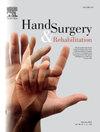对金属过敏:梯形跖骨假体怎么样?
IF 0.9
4区 医学
Q4 ORTHOPEDICS
引用次数: 0
摘要
植入物过敏是骨科文献中一个新兴的话题,但其在非负重假体中的流行程度文献很少,文献中仅报道了3例关于斜骨腕关节置换术的病例。本研究的目的是评估在疑似金属过敏病例中移除斜骨腕假体后的临床结果。这项回顾性队列研究的时间跨度为2004年至2024年。我们纳入了所有怀疑由金属过敏引起的斜跖骨植入失败的病例。分析的标准包括假体类型、过敏的临床症状(疼痛、瘙痒、局部皮炎)、放射学征象(骨溶解或无菌性松动)、皮肤贴试验(假体成分阳性)、术中发现、组织学状态、治疗和假体移除或置换后的结果。排除标准包括感染、种植体错位或创伤史。19名女性和2名男性被纳入研究,随访时间为23个月。Electra®植入物9个,Rubis II®植入物7个,Camargue®植入物5个,Moovis®植入物2个。所有病例均表现出持续的非机械性疼痛。肿胀5例,皮炎3例。与神经神经营养不良的病例不同,所有的腕关节都保持灵活。影像学检查发现骨溶解12例,其中4例有明显的无菌性松动,10例未见病理改变。对18例患者进行皮肤贴片试验,每位患者至少有一种假体成分呈阳性结果(14例钴,2例铬钴,3例镍和1例钛)。术中所有患者均出现滑膜炎,金属对金属假体肉眼可见金属病特别明显,半数患者骨松解、松动,但未见金属病组织学征象。在所有病例中,假体移除或置换后症状减轻或消失。虽然罕见,但如果出现持续的、无法解释的症状,应考虑种植体过敏。管理层应充分披露这种情况的不确定性。确认金属过敏诊断的唯一方法可能是移除植入物后症状的消退。根据我们的经验,翻修或置换手术容易出现并发症,而且往往比初次手术更复杂。因此,在有皮肤金属过敏史或对其他骨科材料过敏的病例中,我们建议使用低过敏性假体作为第一选择。金属植入物过敏仍然是一种排除性诊断,没有诊断或治疗的指导方针。彻底调查这种情况是必要的。本文章由计算机程序翻译,如有差异,请以英文原文为准。
Allergie aux métaux : qu’en est-il de la prothèse trapézo-métacarpienne ?
Allergy to implants is an emerging topic in orthopedic literature, yet its prevalence in non-weight-bearing prostheses is poorly documented, with only 3 cases described in the literature for trapeziometacarpal arthroplasty. The objective of this study was to evaluate the clinical outcomes following the removal of trapeziometacarpal prosthesis in suspected cases of metal allergy.
This retrospective cohort study spans from 2004 to 2024. We included all cases of trapeziometacarpal implant failure suspected to be due to metal allergy. Criteria analyzed included type of prosthesis, clinical signs of allergy (pain, itching, local dermatitis), radiological signs (bone lysis or aseptic loosening), skin patch tests (positive for prosthesis components), intraoperative findings, histological status, treatment, and outcomes after implant removal or replacement. Exclusion criteria included signs of infection, implant malposition, or a history of trauma.
Nineteen women and two men were included, with a follow-up period of 23 months. There were 9 Electra®, 7 Rubis II®, 5 Camargue®, and 2 Moovis® implants. All cases exhibited persistent, non-mechanical pain. Swelling was observed in 5 cases and dermatitis in 3 patients. All trapeziometacarpal joints remained flexible, unlike in cases of algoneurodystrophy. Radiologically, 12 cases of bone lysis were observed, with significant aseptic loosening in 4 cases, while no pathological findings were noted in 10 patients. Skin patch tests were conducted on 18 patients, with positive results for at least one component of the prosthesis in each patient (14 cobalt, 2 chrome-cobalt, 3 nickel, and 1 titanium). Intraoperatively, synovitis was observed in all patients, with macroscopic metallosis particularly evident in metal-on-metal prostheses, and bone lysis and loosening in half of the patients but no histological signs of metallosis were found. In all cases, symptoms either diminished or disappeared following prosthesis removal or replacement.
Although rare, implant allergy should be considered in cases of persistent, unexplained symptoms. Management should include full disclosure about the uncertain nature of this condition. The only way to confirm a diagnosis of metal allergy may be the resolution of symptoms after implant removal. In our experience, revision or replacement surgeries are prone to complications and are often more complex than the initial surgery. Therefore, in cases with a history of dermal metal allergy or allergy to other orthopedic materials, we recommend the use of hypoallergenic prostheses as a first option.
Metal implant allergy remains a diagnosis of exclusion, with no guidelines for either diagnosis or treatment. It is essential to investigate this condition thoroughly.
求助全文
通过发布文献求助,成功后即可免费获取论文全文。
去求助
来源期刊

Hand Surgery & Rehabilitation
Medicine-Surgery
CiteScore
1.70
自引率
27.30%
发文量
0
审稿时长
49 days
期刊介绍:
As the official publication of the French, Belgian and Swiss Societies for Surgery of the Hand, as well as of the French Society of Rehabilitation of the Hand & Upper Limb, ''Hand Surgery and Rehabilitation'' - formerly named "Chirurgie de la Main" - publishes original articles, literature reviews, technical notes, and clinical cases. It is indexed in the main international databases (including Medline). Initially a platform for French-speaking hand surgeons, the journal will now publish its articles in English to disseminate its author''s scientific findings more widely. The journal also includes a biannual supplement in French, the monograph of the French Society for Surgery of the Hand, where comprehensive reviews in the fields of hand, peripheral nerve and upper limb surgery are presented.
Organe officiel de la Société française de chirurgie de la main, de la Société française de Rééducation de la main (SFRM-GEMMSOR), de la Société suisse de chirurgie de la main et du Belgian Hand Group, indexée dans les grandes bases de données internationales (Medline, Embase, Pascal, Scopus), Hand Surgery and Rehabilitation - anciennement titrée Chirurgie de la main - publie des articles originaux, des revues de la littérature, des notes techniques, des cas clinique. Initialement plateforme d''expression francophone de la spécialité, la revue s''oriente désormais vers l''anglais pour devenir une référence scientifique et de formation de la spécialité en France et en Europe. Avec 6 publications en anglais par an, la revue comprend également un supplément biannuel, la monographie du GEM, où sont présentées en français, des mises au point complètes dans les domaines de la chirurgie de la main, des nerfs périphériques et du membre supérieur.
 求助内容:
求助内容: 应助结果提醒方式:
应助结果提醒方式:


